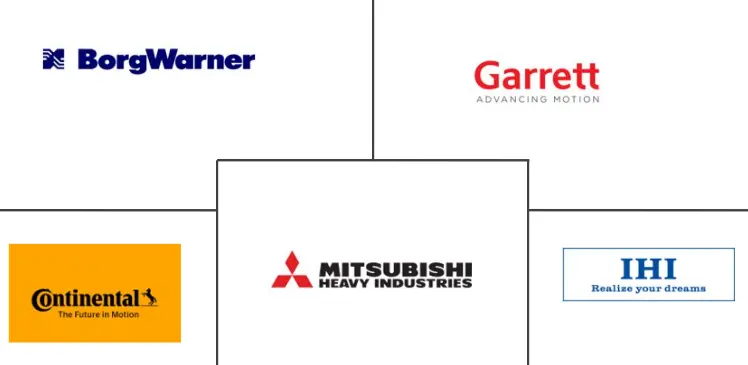Automotive Turbocharger Market Size and Share
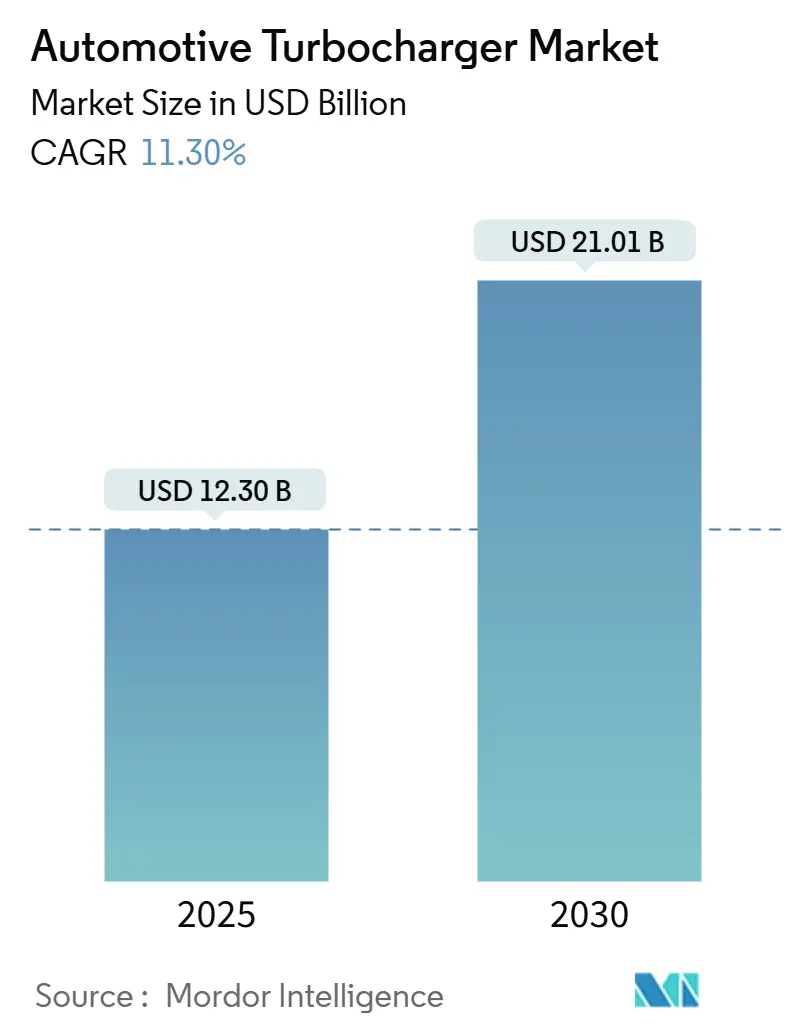
Automotive Turbocharger Market Analysis by Mordor Intelligence
The automotive turbocharger market reached USD 12.30 billion in 2025 and is forecast to climb to USD 21.01 billion by 2030, reflecting an 11.30% CAGR. Persistent emissions mandates, engine-downsizing strategies, and the shift to hybrid powertrains drive the turbocharger market toward higher-efficiency, electric-assist, and hydrogen-ready solutions. Technology spending is moving quickly from simple wastegate architectures to variable geometry and 48 V e-boost systems that can meet Euro 7 and similar regulations.[1]"EU Euro 7 Emissions Regulation Published", InterRegs, www.interregs.com. Automakers view electric turbochargers as the most direct path to near-instant torque delivery without compromising fleet-average fuel economy. At the same time, component makers prioritize designs that suit fuel-cell air management. Competitive dynamics remain intense because the top five suppliers already supply most global volume. Yet, each is racing to secure design wins in hydrogen ICE, fuel-cell, and 400 V hybrid platforms.
Key Report Takeaways
- By vehicle type, passenger cars led the turbocharger market with 54.11% of the share in 2024, while off-highway equipment is projected to expand at a 12.90% CAGR to 2030.
- By fuel type, diesel engines held 60.51% of the turbocharger market size in 2024; hydrogen ICE applications post the fastest growth at 26.30% through 2030.
- By sales channel, OEM fitment commanded 77.81% share of the turbocharger market size in 2024, whereas the replacement aftermarket is advancing at a 9.40% CAGR.
- By turbo technology, wastegate units accounted for 44.21% of the market share in 2024, and electric turbochargers show the highest projected CAGR at 19.11%.
- By geography, Asia-Pacific dominates the global turbocharger market with a 48.89% share in 2024, while the Middle East and Africa region is forecast to grow the fastest at 13.23% CAGR.
Global Automotive Turbocharger Market Trends and Insights
Drivers Impact Analysis
| Driver | (~) % Impact on CAGR Forecast | Geographic Relevance | Impact Timeline |
|---|---|---|---|
| Stricter CO₂ and NOx Legislation Accelerating Turbo-gasoline Adoption | +2.8% | Global, with EU and China leading implementation | Medium term (2-4 years) |
| Engine Downsizing for Fleet-average Fuel-economy Compliance | +2.1% | North America and EU, expanding to Asia-Pacific | Long term (≥ 4 years) |
| Rising Commercial-vehicle Output in Asia-Pacific Elevates Turbo Demand | +1.9% | Asia-Pacific core, spill-over to MEA | Short term (≤ 2 years) |
| OEM shift to 48V Electric-assist Turbos for Transient Response | +1.7% | Global, with premium segment early adoption | Medium term (2-4 years) |
| Integration of e-turbos in Hybrid and Plug-in Hybrid Architectures | +1.4% | North America and EU, expanding globally | Long term (≥ 4 years) |
| Early Adoption in Hydrogen ICE and Fuel-cell Air-compression Stacks | +1.0% | EU and Japan leading, with global expansion | Long term (≥ 4 years) |
| Source: Mordor Intelligence | |||
Stricter CO₂ and NOx Legislation Accelerating Turbo-Gasoline Adoption
Emissions regulations are fundamentally altering turbocharger deployment strategies across global automotive markets. The Euro 7 regulation introduces particulate number limits for spark ignition vehicles and mandates gasoline particulate filters for all engines, creating technical requirements that favor turbocharged configurations. Light-duty gasoline engines must integrate enhanced fuel injection and combustion technologies to meet ultra-low emissions thresholds, positioning turbochargers as essential for achieving required power density while maintaining emissions compliance. The regulation's phased implementation creates sustained demand for variable geometry turbochargers to optimize exhaust gas recirculation and aftertreatment system efficiency. This regulatory framework extends beyond Europe, with China and India implementing similar standards, representing over 40% of global vehicle production. The technical complexity of meeting these standards while maintaining performance characteristics drives manufacturers toward sophisticated turbocharging solutions that can modulate boost pressure in real-time based on emissions requirements.
Engine Downsizing for Fleet-Average Fuel-Economy Compliance
Fleet-average fuel economy regulations are compelling manufacturers to extract maximum efficiency from smaller displacement engines through advanced turbocharging. The Corporate Average Fuel Economy standards in North America and similar regulations in Europe create economic incentives for manufacturers to replace larger naturally aspirated engines with smaller turbocharged alternatives. This trend enables manufacturers to maintain performance characteristics while achieving significant fuel economy improvements, with turbocharged engines delivering 20-40% better fuel efficiency compared to naturally aspirated equivalents. The downsizing strategy particularly benefits from twin-scroll and variable geometry turbocharger technologies that minimize turbo lag while maximizing low-end torque production. Manufacturers are increasingly adopting integrated exhaust manifold designs and electric wastegate actuators to optimize transient response characteristics. The economic pressure to meet fleet-average targets creates sustained demand for turbocharging solutions across vehicle segments, from compact passenger cars to mid-size SUVs where downsizing strategies yield the greatest compliance benefits.
Rising Commercial-Vehicle Output in Asia-Pacific Elevates Turbo Demand
Commercial vehicle production expansion across Asia-Pacific markets generates substantial turbocharger demand driven by infrastructure development and logistics sector growth. China's heavy-duty truck market rebounded to approximately 900,000 units in 2023 following a 45% decline in 2022, with CNG and LNG trucks gaining market share due to lower fuel costs and emissions advantages. The shift toward alternative fuel powertrains creates opportunities for specialized turbocharger designs optimized for natural gas combustion characteristics. Indonesia's heavy truck market maintained stability at 26,325 units in 2023, with Japanese manufacturers dominating the segment and driving demand for reliable turbocharging solutions. The region's focus on intercity road network improvements and logistics infrastructure development sustains demand for turbocharged commercial vehicles. Mitsubishi Heavy Industries expanded its Chinese turbocharger production capacity by 20% annually to meet rising local demand, establishing four additional assembly lines to achieve an annual output of 4.35 million units.[2]"Mitsubishi Heavy revving up Chinese turbocharger output", Nikkei Asia, asia.nikkei.com. This capacity expansion reflects manufacturers' confidence in sustained Asia-Pacific commercial vehicle growth and the region's strategic importance for global turbocharger supply chains.
OEM Shift to 48V Electric-Assist Turbos for Transient Response
Automotive manufacturers are integrating 48V electric-assist turbochargers to address transient response limitations while maintaining fuel efficiency benefits. Garrett Motion's 48-volt electric compressor technology enables rapid boost delivery within 300 milliseconds, eliminating traditional turbo lag characteristics that limit consumer acceptance. Technology integrates seamlessly with existing mild-hybrid architectures, providing instantaneous torque delivery at low engine speeds while supporting regenerative braking systems. BorgWarner's eBooster technology eliminates turbo lag entirely through electrically driven compression, allowing smaller high-performance turbocharged engines to deliver naturally aspirated response characteristics. These systems operate independently of exhaust gas flow, enabling precise boost control across all engine operating conditions. The 48V architecture provides sufficient power for high-speed electric motors while maintaining cost competitiveness compared to high-voltage hybrid systems. Valeo's electric supercharger technology delivers boost within 300 milliseconds using switched-reluctance motors, improving fuel economy by up to 20% when combined with regenerative braking capabilities. This technological convergence positions electric-assist turbochargers as essential components for next-generation powertrain architectures that balance performance, efficiency, and emissions compliance.
Restraints Impact Analysis
| Restraint | (~) % Impact on CAGR Forecast | Geographic Relevance | Impact Timeline |
|---|---|---|---|
| Rapid BEV Penetration Eliminates Forced-Induction Requirements | -2.3% | Global, with EU and China leading adoption | Medium term (2-4 years) |
| Competitive Cost of Modern Naturally-Aspirated Engines in Less Than 1.2L | -1.1% | Asia-Pacific markets, particularly India and Southeast Asia | Short term (≤ 2 years) |
| Turbo-Lag Perception Limiting Consumer Acceptance in Key Markets | -0.8% | North America and emerging APAC markets | Short term (≤ 2 years) |
| Critical-Metal (Nd-Fe-B) Supply Risk for High-Speed E-Machine Rotors | -0.6% | Global, with China controlling rare earth supply | Long term (≥ 4 years) |
| Source: Mordor Intelligence | |||
Rapid BEV Penetration Eliminates Forced-Induction Requirements
Battery electric vehicle adoption creates structural headwinds for turbocharger demand as manufacturers transition production capacity toward electric powertrains. The fundamental architecture of BEVs eliminates internal combustion engines, removing the need for forced induction systems and creating a zero-sum relationship between electric vehicle penetration and turbocharger market growth. China's new energy vehicle market demonstrates this dynamic, with BEV sales growth directly correlating with reduced demand for traditional turbocharging solutions. However, the transition creates opportunities for turbocharger manufacturers in fuel cell applications, where compressed air delivery systems require specialized centrifugal compressors. IHI Corporation developed electric turbochargers specifically for hydrogen fuel cell systems, featuring oil-free operation and mechatronic integration to optimize fuel cell efficiency[3]"Electric TurboCharger(ETC) for hydrogen-based fuel cell systems," IHI, ihi.co.jp.. The technology addresses fuel cell air supply requirements while maintaining turbocharger manufacturers' core competencies in rotating machinery and aerodynamic design.
Competitive Cost Of Modern Naturally-Aspirated Engines in Less than 1.2L
Small displacement naturally aspirated engines present cost-competitive alternatives to turbocharged configurations in price-sensitive market segments. Modern naturally aspirated engines under 1.2 liters achieve acceptable performance characteristics while avoiding the complexity and cost associated with turbocharging systems. This dynamic particularly affects emerging markets where vehicle affordability remains paramount and consumers prioritize initial purchase price over long-term fuel efficiency benefits. The cost differential becomes more pronounced when considering the additional components required for turbocharged engines, including intercoolers, boost control systems, and enhanced cooling requirements. Manufacturers in India and Southeast Asia continue to offer naturally aspirated variants in compact vehicle segments, where the performance benefits of turbocharging may not justify the additional cost burden. However, this restraint diminishes as emissions regulations tighten and fuel economy standards become more stringent, forcing manufacturers to adopt turbocharging even in entry-level segments. Developing low-cost turbocharger technologies, including simplified wastegate designs and integrated exhaust manifolds, helps manufacturers maintain price competitiveness while meeting regulatory requirements.
Segment Analysis
By Vehicle Type: Off-highway Drives Mechanization Surge
Passenger cars, by contrast, hold the largest turbocharger market share at 54.11% in 2024, due to the widespread use of small, turbo-gasoline engines that satisfy fleet targets. Commercial trucks and buses contribute 22%, and light commercial vans make up 18%. Equipment makers now specify variable-geometry and electrically assisted units that maintain boost under constant-speed operation and dusty conditions. Off-highway machinery is on track for a 12.90% CAGR between 2025 and 2030, the fastest in the global turbocharger market.
The agriculture and construction machinery boom in developing economies underpins this momentum. Turbo suppliers are designing water-cooled bearing housings and wider compressor maps for these harsh duty cycles. As emissions laws reach non-road engines, OEMs adopt exhaust-aftertreatment that works best with a responsive turbo. The turbocharger market size allocated to off-highway platforms therefore, scales in tandem with government spending on rural mechanization and infrastructure builds. OEM service programs also push remanufactured units to control lifecycle cost and keep uptime high.
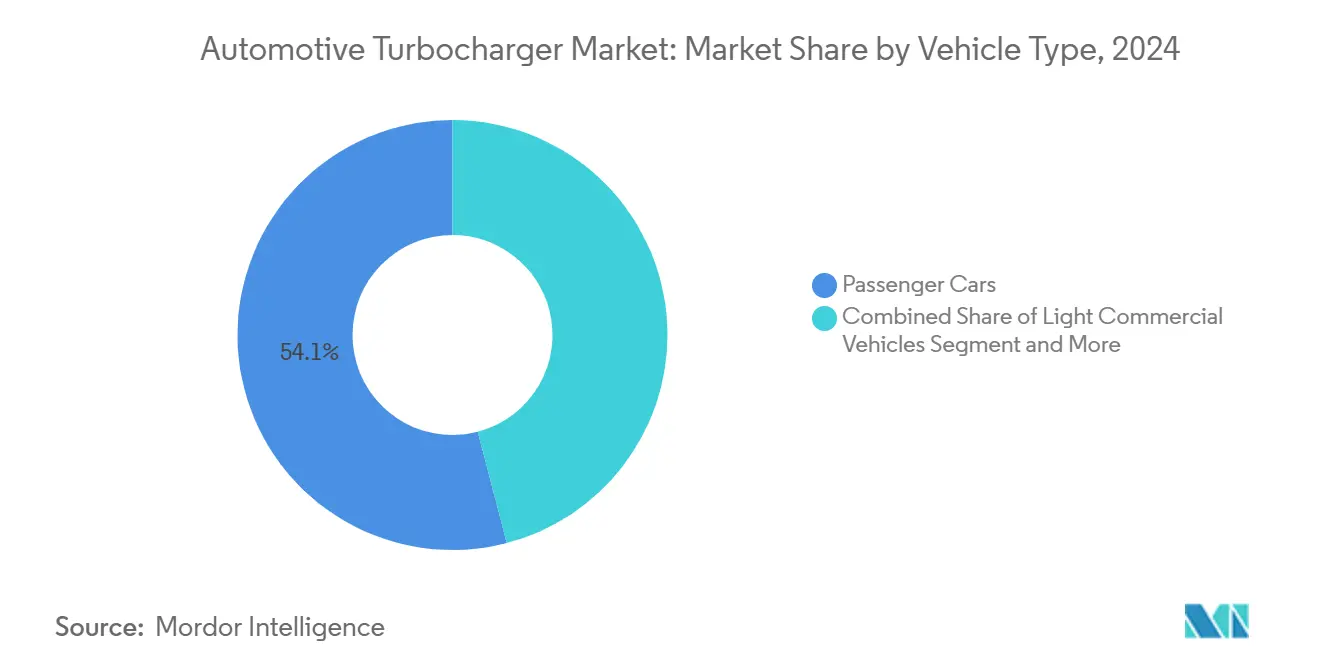
Note: Segment shares of all individual segments available upon report purchase
By Fuel Type: Hydrogen ICE emerges as growth catalyst
Diesel held 60.51% of the turbocharger market size in 2024 because of its dominance in freight and off-highway segments, yet hydrogen ICE applications will accelerate at a 26.30% CAGR. Cummins’ new hydrogen engine turbo features bespoke aerodynamics to cope with higher exhaust flow and water vapor. Gasoline engines account for 32%, lifted by Euro 7 conformity, while CNG and LPG combined sit at 6%.
Hydrogen ICE testing shows up to 165% more power with turbocharging compared to naturally aspirated modes, and zero-carbon combustion is possible when renewable hydrogen is used. Turbo suppliers are therefore investing in seals and stainless materials that defeat hydrogen embrittlement. The turbocharger market share for hydrogen systems is low today, but strong policy backing positions it as a strategic segment for decade-end growth.
By Sales Channel: Aftermarket gains momentum amid fleet aging
OEM fitment represented 77.81% of the turbocharger market in 2024 because every new light vehicle in Europe and over 60% in China now ships with a turbo. However, the replacement segment will grow at 9.40% CAGR as the global turbocharger fleet ages. Modern variable-geometry vanes suffer erosion and require precise calibration, so many fleets choose factory-approved reman units to keep warranties intact.
Garrett’s aftermarket division already supplies 14% of total revenue. BorgWarner launched nine new replacement models in 2024 for BMW and Porsche, illustrating demand from premium car workshops. Distributors also report higher demand for upgraded actuators and e-motor repair kits, evidence that the turbocharger industry now blends hardware with electronic service offerings.
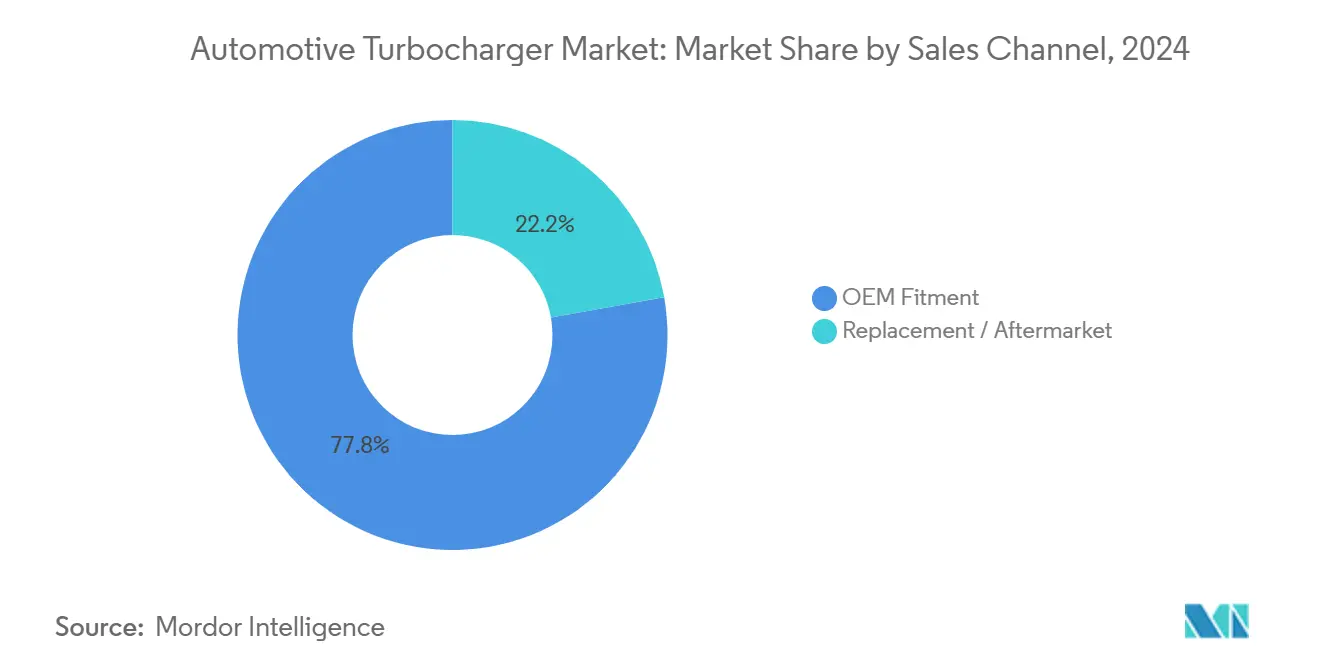
Note: Segment shares of all individual segments available upon report purchase
By Turbo Technology: Electric systems reshape performance paradigms
Wastegate designs retained 44.21% of the turbocharger market share in 2024 because they balance cost and durability in high-volume vehicles. Variable geometry units totaled 36%, most in light-duty diesel and emerging gasoline variants that need precise exhaust energy control. Twin-scroll accounted for 14%, favored by performance models.
Electric turbochargers will grow at 19.11% CAGR as 48 V mild hybrids move mainstream. Garrett’s E-Turbo integrates an e-motor on the shaft, delivering boost irrespective of exhaust mass flow. Ferrari’s 2024 patent for a gear-driven module signals parallel mechanical innovation. Automakers are also experimenting with blended e-turbos that recover turbine energy and feed it back to the crankshaft or a 48 V battery pack. As a result, the turbocharger market size allocated to electric-assist designs is expected to quadruple by 2030.
Geography Analysis
Asia-Pacific dominates the global turbocharger market with a 48.89% share in 2024, reflecting the region's position as the world's largest automotive manufacturing hub and fastest-growing vehicle market, while the Middle East and Africa region is forecast to grow the fastest at 13.23% CAGR. China's heavy-duty trucking industry demonstrates the region's market dynamics, with approximately 900,000 units sold in 2023 following recovery from previous year declines. CNG and LNG trucks gain market share due to lower fuel costs and advantages in emissions. The region benefits from substantial manufacturing capacity expansion, with Mitsubishi Heavy Industries increasing Chinese turbocharger production by 20% annually to meet rising local demand, establishing four additional assembly lines to achieve an annual output of 4.35 million units.
Europe maintains a significant market share, driven by stringent emissions regulations and technological leadership in advanced turbocharger systems. The European Union's Euro 7 emissions regulation, published in May 2024, mandates stricter NOx and particulate matter limits while introducing onboard monitoring systems for emissions compliance, creating sustained demand for variable geometry and electric turbocharger technologies. The regulation's implementation timeline, spanning 2026 to 2034 across vehicle categories, positions Europe as a testing ground for next-generation turbocharger technologies that will eventually spread to global markets.
North America represents 18.5% of the global market, with growth driven by Corporate Average Fuel Economy standards that incentivize turbocharger adoption across vehicle segments. The region benefits from manufacturers achieving 20-40% fuel efficiency improvements through engine downsizing strategies that rely heavily on advanced turbocharging technologies. Cummins' launch of its next-generation 6.7L Turbo Diesel engine for Ram Heavy Duty trucks in January 2025, featuring a new variable-geometry turbocharger and improved air management systems, demonstrates the region's focus on high-performance commercial vehicle applications. The North American market's emphasis on pickup trucks and commercial vehicles creates demand for robust turbocharger designs capable of handling high-torque applications, while the region's adoption of 48V mild-hybrid systems drives innovation in electric-assist turbocharger technologies.
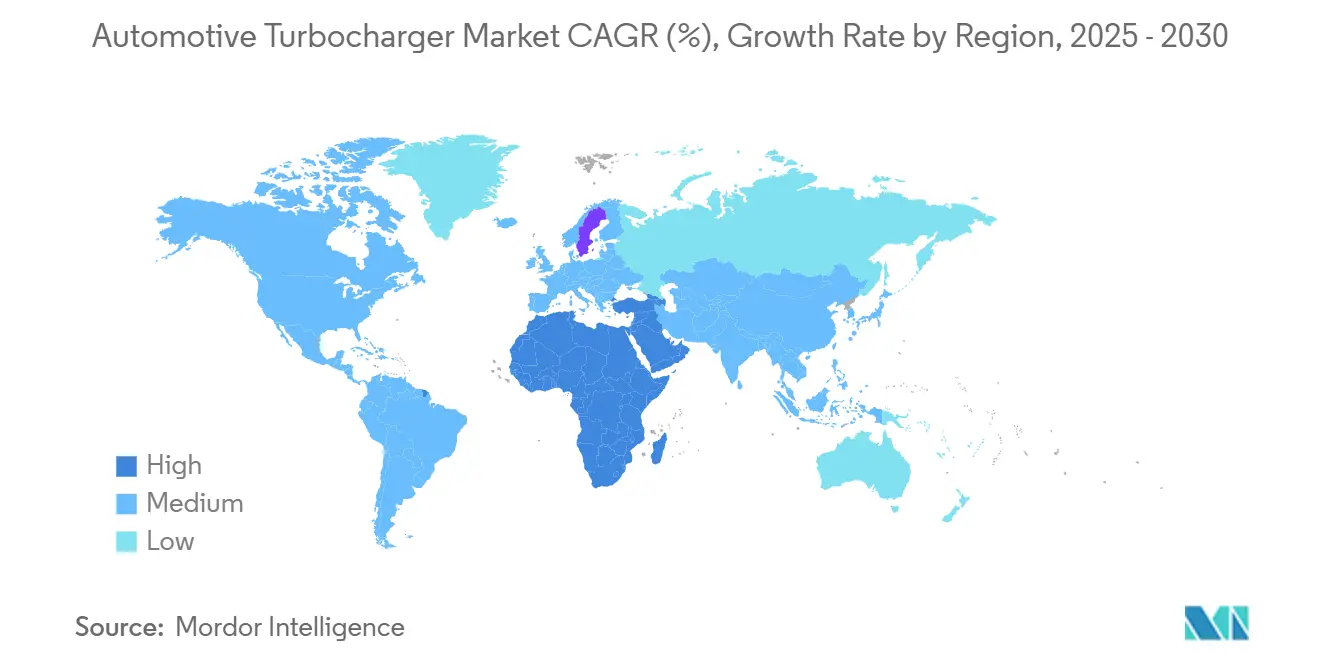
Competitive Landscape
The turbocharger market exhibits high concentration, with the top 5 manufacturers controlling a significant percentage of global market share, creating intense competitive dynamics among established players. This concentrated structure reflects the significant capital and technology barriers required for advanced turbocharger development and mass production. Regional market dynamics heavily influence the competitive landscape, with Asia-Pacific commanding 48.89% of global market share, Europe 25%, and North America 18.5%. This geographic distribution underscores the strategic importance of Asian manufacturing capabilities and the region's role as both a production hub and end market for turbocharged vehicles.
Strategic positioning varies significantly across regions. Asian manufacturers like IHI Corporation and Mitsubishi Heavy Industries leverage proximity to major automotive production centers to capture market share through cost-competitive solutions and rapid capacity expansion. European and North American players, including BorgWarner and Garrett Motion, focus on technological differentiation through electric turbocharging and hydrogen-compatible systems to maintain premium positioning despite lower regional market shares.
The emerging markets of South America, as well as the Middle East and Africa, present white-space opportunities for market expansion, particularly as infrastructure development and commercial vehicle adoption accelerate in these regions. Ferrari's patent activity around gear-driven turbocharger systems exemplifies how intellectual property is being used to secure competitive advantage in a rapidly evolving market. The industry's pivot toward electrification and alternative fuels creates disruption risk for traditional players and opportunities for smaller contenders to challenge incumbents through specialized electric turbo solutions and digital service integration.
Automotive Turbocharger Industry Leaders
-
BorgWarner Inc.
-
Continental AG
-
Mitsubishi Heavy Industries Ltd
-
IHI Corporation
-
Garrett Motion Inc.
- *Disclaimer: Major Players sorted in no particular order
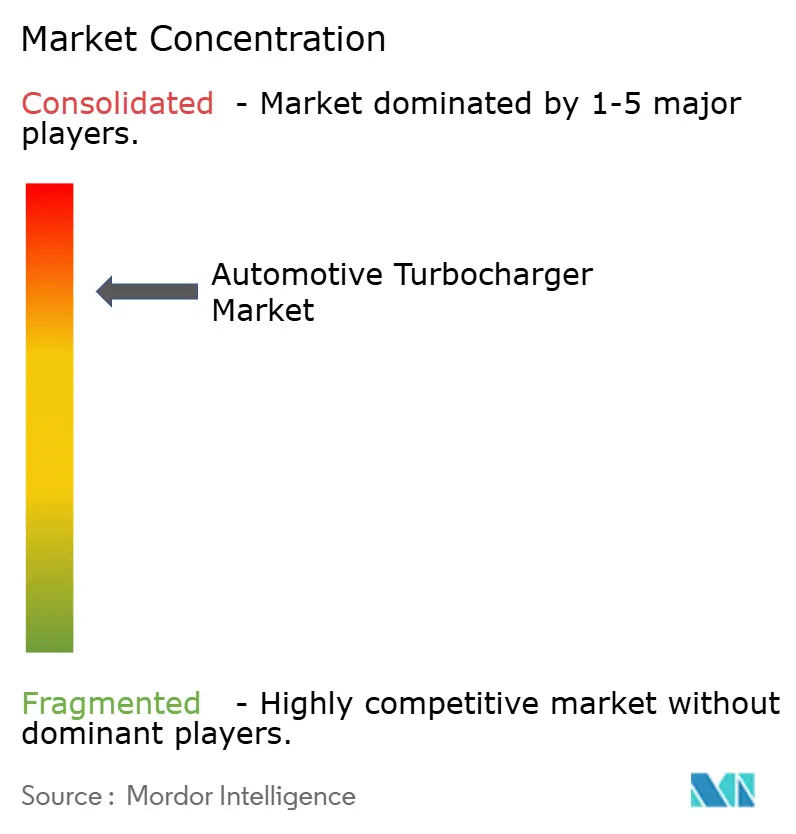
Recent Industry Developments
- April 2025: Cummins launched its industry-first hydrogen internal combustion engine turbocharger for on-highway applications in Europe, featuring advanced aerodynamics and prognostics to address hydrogen’s combustion challenges.
- January 2025: Cummins launched its next-generation 6.7L Turbo Diesel engine for Ram Heavy Duty trucks, featuring a new variable-geometry turbocharger and improved air management for higher output and serviceability .
Global Automotive Turbocharger Market Report Scope
A turbocharger is a turbine-driven forced induction device that increases the internal combustion (IC) engine efficiency and energy output by sending extra compressed air into the combustion chamber. The automotive turbocharger market study covers the penetration of turbochargers into passenger cars and commercial vehicles, the latest product developments, government regulations pertaining to the use of turbochargers, and market shares of the players operating in the industry.
The automotive turbocharger market is segmented by Vehicle type, Fue Type, and Geography. By Fuel type, the market is segmented into passenger cars and commercial vehicles. By fuel type, the market is segmented into gasoline and diesel.
By sales channel, the market is segmented into OEM and replacement/aftermarket, and by geography, the market is segmented into North America, Europe, Asia-Pacific, and Rest of the World. For each segment, market size and forecast have been done on the basis of value (USD billion).
| Passenger Cars |
| Light Commercial Vehicles |
| Medium and Heavy Commercial Vehicles |
| Off-highway (Agricultural, Construction) |
| Gasoline |
| Diesel |
| CNG/LPG |
| Hydrogen Internal-Combustion |
| OEM Fitment |
| Replacement / Aftermarket |
| Wastegate Turbocharger |
| Variable Geometry Turbocharger (VGT) |
| Twin-Scroll Turbocharger |
| Electric Turbocharger |
| North America | United States |
| Canada | |
| Rest of North America | |
| South America | Brazil |
| Argentina | |
| Rest of South America | |
| Europe | Germany |
| United Kingdom | |
| France | |
| Italy | |
| Spain | |
| Russia | |
| Rest of Europe | |
| Asia-Pacific | China |
| India | |
| Japan | |
| South Korea | |
| Australia and New Zealand | |
| Rest of Asia-Pacific | |
| Middle East and Africa | Turkey |
| Saudi Arabia | |
| United Arab Emirates | |
| South Africa | |
| Rest of Middle East and Africa |
| By Vehicle Type | Passenger Cars | |
| Light Commercial Vehicles | ||
| Medium and Heavy Commercial Vehicles | ||
| Off-highway (Agricultural, Construction) | ||
| By Fuel Type | Gasoline | |
| Diesel | ||
| CNG/LPG | ||
| Hydrogen Internal-Combustion | ||
| By Sales Channel | OEM Fitment | |
| Replacement / Aftermarket | ||
| By Turbo Technology | Wastegate Turbocharger | |
| Variable Geometry Turbocharger (VGT) | ||
| Twin-Scroll Turbocharger | ||
| Electric Turbocharger | ||
| By Geography | North America | United States |
| Canada | ||
| Rest of North America | ||
| South America | Brazil | |
| Argentina | ||
| Rest of South America | ||
| Europe | Germany | |
| United Kingdom | ||
| France | ||
| Italy | ||
| Spain | ||
| Russia | ||
| Rest of Europe | ||
| Asia-Pacific | China | |
| India | ||
| Japan | ||
| South Korea | ||
| Australia and New Zealand | ||
| Rest of Asia-Pacific | ||
| Middle East and Africa | Turkey | |
| Saudi Arabia | ||
| United Arab Emirates | ||
| South Africa | ||
| Rest of Middle East and Africa | ||
Key Questions Answered in the Report
What is the current size of the turbocharger market?
The turbocharger market stands at USD 12.30 billion in 2025 and is projected to reach USD 21.01 billion by 2030.
Which turbo technology segment is growing the fastest?
Electric turbochargers are expanding at a 19.11% CAGR as 48 V mild-hybrid systems proliferate.
How does Euro 7 influence turbocharger demand?
Euro 7 tightens particulate and NOx limits, making advanced variable-geometry and electric-assist turbos essential for compliance.
Which region will see the quickest turbocharger market growth by 2030?
The Middle East and Africa region leads with a forecast 13.2% CAGR due to infrastructure spending and commercial-vehicle expansion.
Page last updated on:
